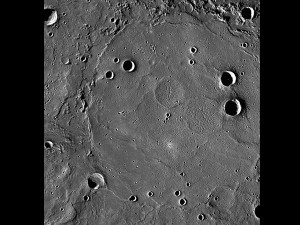Ancient river-like volcanoes formed Mercury’s plains
WASHINGTON—The planet closest to the Sun had plenty of its own heat to release billions of years ago and erupted in vast river-like volcanoes that oozed around its northern pole, said a study out Thursday.
For more than three decades, scientists have thought volcanoes may have helped craft Mercury’s smooth northern plains but they have learned much more since a NASA spacecraft began orbiting Mercury for the first time this year.
A series of reports in the journal Science describe what NASA’s MESSENGER probe — which stands for MErcury Surface, Space ENvironment, GEochemistry, and Ranging — has found since it began circling Mercury in mid-March.
Between 3.5 and four billion years ago, volcanic cracks opened in the crust and gushed lava, forming plains across six percent of the tiny hot planet, covering an area as big as 60 percent of the United States, said the study.
These were not the mountain-like volcanoes that form gradually over time, like the ones seen in Hawaii, but gash-like vents that unleashed scorching lava rivers that in some places ran two kilometers (1.2 miles) deep.
“These huge vents, measuring up to 25 kilometers (15 miles) in length, appear to be the source of tremendous volumes of very hot lava that rushed out over the surface of Mercury,” said co-author James Head, professor of geological sciences at Brown University.
The lava flows pushed across the surface, “carving valleys and creating teardrop-shaped ridges in the underlying terrain,” Head said.
“This one deposit is so huge, volcanism has got to be important elsewhere.”
Volcanoes have had a role in the forming other planets, including Mars, and they help a planet release its inner heat.
On Earth, similar types of volcanoes known as basalt floods in the western United States formed the terrain along the Columbia River in Washington and Oregon some 12-17 million years ago, according to the US Geological Survey.
Scientists gained a few glimpses of Mercury’s surface from a trio of MESSENGER flybys. The probe was launched in 2004, made a few passes near Mercury and finally entered its orbit on March 18.
The very first look at Mercury came from Mariner 10, an earlier probe that made three passes of Mercury in 1974 and 1975 mapped out about 45 percent of the surface of the planet.
NASA hopes MESSENGER will shed more light on the composition of the surface of Mercury as it continues its orbit of the planet every 12 hours at a minimum altitude of 124 miles (200 kilometers).
Other findings from MESSENGER’s instruments show that Mercury is pummeled by solar wind, or highly charged particles that emanate from the Sun.
Mercury has no atmosphere, which means it can reach temperatures of 800 degrees Fahrenheit (430 Celsius) due to its closeness to the Sun, but also loses all that heat when the surface turns away, dipping to -230 F (-170 C).
The planet is the only one besides Earth to have a magnetic field around it, but Mercury’s is so weak that it does not build the same tough shield against solar radiation.
“Our results tell us is that Mercury’s weak magnetosphere provides very little protection of the planet from the solar wind,” said co-author Thomas Zurbuchen, a professor at the University of Michigan College of Engineering.
Mercury is named after the Roman messenger god, with many craters which make its surface resemble the Moon.
It is the smallest of the eight planets, about a third the size of Earth and almost as dense, and orbits the Sun about every 88 Earth days.
